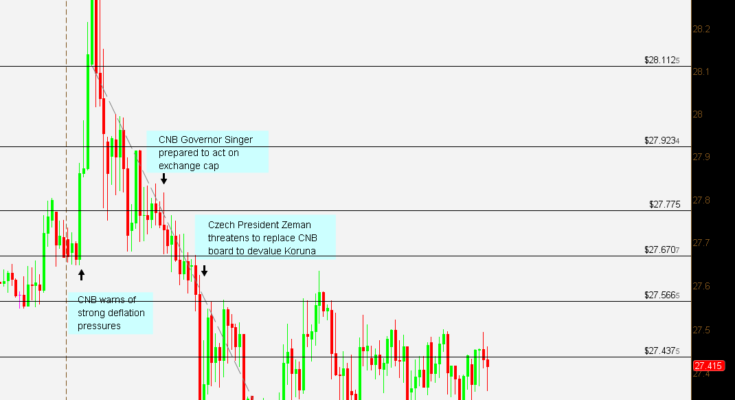The Czech Republic entered the EU in 2004. The Czech Republic is landlocked bordering Germany in the west and north, Poland in the north and east, Slovakia east and south and Austria in the south. Its total land area is 77,247 km2, about the size of Scotland. Natural resources are sparse, mostly coal, clay, graphite, timber with 40.88% of its land area arable and there are small amounts of petroleum and gas.
According to the WTO the Czech Republic ranks 30th in exports and 31st in imports of total global trade, excluding intra-EU trade.
Guest post by Mike Scrive of Accendo Markets

Its major export partners are: Germany, 29.68% of all exports; Slovakia, 7.42%; Poland, 5.29%; France, 5.27% and U.K. at 4.96%. Its major export products are: Autos, 10.19%; Vehicle Parts, 6.84%; Computers, 6.26%; Rubber Tires, 1.64% and Telephones at 1.63%. Specifically, top trading partner Germany imports Vehicle Parts, 9.97% of all exports to Germany; Autos, 8.58%; Computers, 5.69%; Insulated Wire, 2.62% and Video Displays at 2.19%. Autos and auto parts account for 18.55% of total Czech exports to Germany; 10.36% of total exports to Slovakia; 11.96% of total exports to Poland; 22.93% to France and 19.48% to the U.K. Hence it’s fair to say that a large portion of the Czech manufacturing sector is auto or auto parts related.
Its major import partners are: Germany, 25.80% of all imports; China, 10.52%; Poland, 7.27%; Slovakia, 6.29% and Russia, 4.91%. Top import products include: Vehicle Parts, 5.25%; Computers, 5.15%; Petroleum Gas, 3.48%, Crude Petroleum, 3.32% and Office Machine Parts, 2.19%. Again, the largest portion of imports is from Germany. They include: Vehicle Parts, 8.76%; Autos, 2.46%, GFPC 1.94%; Petroleum Gas, 1.94% and Plastics, 1.78%. Computer imports from China factor heavily at 29.86% of all Chinese imports; Vehicle Parts from Slovakia and Poland account for 11.36%. It may be concluded that Czech Republic, Poland, Slovakia and Germany have an integrated Automobile manufacturing trade.
The Czech Republic depends on Russia for oil, gas and nuclear reactor grade fuel. Â Czech imports from Russia are: Crude Petroleum, 43.91%; Petroleum Gas, 37.53% and Nuclear Fuel, 2.52%. Over 19% of electricity is generated from nuclear, 5.2% from hydroelectric, over 63% from fossil fuels and 11.5% from renewable sources.
According to the Czech Statistical Office, GDP by purchasing power parity is approximately £204.29 billion with a growth rate of 4.2%. The Czech National Bank records an annual inflation rate of 0.4%. GDP per capita is approximately £18,441.00. Q4 gross value added increased by 3.8%. Importantly and manufacturing activity increased by 3.4%. Major contributors to GDP are: household spending, 48.2%; government spending, 19.2%; fixed and capital investment, 25%. Unemployment is 6.7%. The Czech National Bank’s benchmark rates are the repurchase rates: overnight deposits, 0.14%; weekly, 0.16%; monthly, 0.22%; 6 months, 0.39% and 1 year, 0.48%. Czech government bonds are rated AA-. Although the Czech Republic initially adopted the Euro, public opinion was against it and the Koruna is the official currency. In 2013 the CNB capped the Koruna, 27 to the Euro. Recently, Further, Fitch affirmed Czech government bonds as A+, stable.
CSO states, “…the GDP growth was caused by both domestic and foreign factors. The trend of strengthening of the domestic demand that started in 2014 continued also in the Q1 2015 and markedly overcame the influence of the foreign demand. Besides an increasing household consumption, what also contributed substantially to the GDP growth were investment activities supported by formation of inventories related to production activities. External trade contribution has relatively decreased; however, it was still positive…†CSO goes on to note contributions to GDP by increases in fixed capital formation.

It’s interesting to note that the Koruna weakened to its low just two days before the surprise Swiss decoupling. The weakening appeared to result from the CNB emphatic deflation warning in early 2015. The Czech National Bank seemed willing to be patient, but the President of the Republic, Milos Zeman wasn’t. He publically stated his opinion that ‘the market was wrong’ and that he was willing to appoint central bankers who would remove the cap. The government pressure served only to create demand for the Koruna, driving it to all-time highs. By the end of March, Poland, Hungary and Romania were defending their own currencies, putting further pressure on the CNB. However, while the Czech National Bank and the Czech government were at loggerheads, economic growth began to accelerate. Q4 GDP measured 2.8% with inflation; up 0.2% in March. Growth was particularly strong in vehicles and machinery manufacturing. This would make sense since, as noted in the trade analysis above, the Czech manufacturing sector turns intermediate goods to finished product for re-export, particularly in the auto sector. Since a weaker Euro is designed to stimulate exports, the Czech economy is benefitting indirectly.
Positive economic data seems to have taken pressure off the CNB for the time being. The current range, 27.332 to 27.503, might only be the calm before the storm. Analyst estimated an appropriate new cap at 28 to 29 per Euro, but the debate will ultimately be decided by domestic economic growth. There is also the possibility that the Czech Republic may adopt the Euro, after all. However, tension between the government and central bank may turn the cap debate into a political issue. It would be best to remain neutral on the pair.
“CFDs, spread betting and FX can result in losses exceeding your initial deposit. They are not suitable for everyone, so please ensure you understand the risks. Seek independent financial advice if necessary. Nothing in this article should be considered a personal recommendation. It does not account for your personal circumstances or appetite for risk.â€



